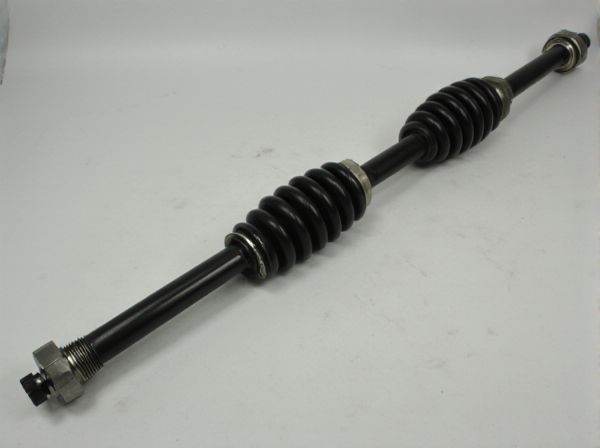
Photo illustration: Greaseable U-Joint vs Non-Greaseable U-Joint
Greaseable U-joints provide the advantage of extended service life through regular maintenance, which helps prevent premature wear and failure. Non-greaseable U-joints, also known as sealed or maintenance-free joints, are pre-lubricated and require no ongoing lubrication, making them ideal for applications where accessibility is limited. Choosing the right U-joint depends on your vehicle's usage and the ease of performing maintenance to ensure optimal performance and durability.
Table of Comparison
| Feature | Greaseable U-Joint | Non-Greaseable U-Joint |
|---|---|---|
| Maintenance | Requires regular greasing for longevity and optimal performance | Sealed; no maintenance needed |
| Durability | Longer lifespan with proper lubrication | Durable but may wear out faster without lubrication |
| Cost | Typically higher initial cost due to maintenance capability | Lower initial cost, but potential for earlier replacement |
| Performance | Better performance in harsh conditions due to re-lubrication | Good performance under normal use, limited in extreme conditions |
| Installation | May require additional fittings for grease lines | Simpler installation, no grease fittings |
Introduction to U-Joints: Function and Importance
Universal joints (U-joints) enable the transfer of rotary motion between two shafts at varying angles, crucial in automotive drivetrains and industrial machinery. Greaseable U-joints feature a grease fitting for regular lubrication, enhancing durability and reducing wear by maintaining optimal friction levels. Non-greaseable U-joints rely on sealed bearings with pre-lubrication, offering maintenance-free operation but potentially reduced lifespan under severe conditions.
What Are Greaseable U-Joints?
Greaseable U-joints are universal joints equipped with a grease fitting that allows for regular lubrication, enhancing durability and reducing wear. These U-joints are designed to accommodate maintenance by enabling grease to penetrate bearing caps, preventing corrosion and extending operational life. In contrast to non-greaseable U-joints, greaseable types provide superior performance in demanding applications through improved lubrication management.
Non-Greaseable U-Joints Explained
Non-greaseable U-joints, also known as sealed U-joints, come pre-lubricated with grease sealed inside the bearing caps, eliminating the need for routine maintenance or lubrication. These joints offer a longer lifespan in normal driving conditions due to their sealed environment, which prevents contamination from dirt and moisture. Ideal for vehicles with limited access to the U-joint or in applications where maintenance is challenging, non-greaseable U-joints provide reliable performance without the risk of neglecting lubrication.
Key Differences Between Greaseable and Non-Greaseable U-Joints
Greaseable U-joints feature a zerk fitting allowing regular lubrication, enhancing durability and performance by reducing friction and wear, whereas non-greaseable U-joints are sealed and maintenance-free but may wear out faster under heavy use. Greaseable U-joints require periodic maintenance, making them ideal for off-road or high-stress applications, while non-greaseable U-joints suit standard driving conditions with less frequent maintenance. Material and design differences influence longevity, with greaseable units often having higher operational life due to proactive lubrication.
Installation Process: Greaseable vs Non-Greaseable
The installation process of greaseable U-joints involves securing the joint followed by attaching a grease fitting for easy lubrication, ensuring prolonged durability and maintenance flexibility. Non-greaseable U-joints require a sealed design, eliminating the need for grease fittings and resulting in a simpler, quicker installation without the need for later lubrication. Choosing between greaseable and non-greaseable U-joints impacts maintenance routines, with greaseable models allowing ongoing lubrication to extend service life.
Maintenance Requirements and Longevity
Greaseable U-joints require regular lubrication maintenance to prevent wear and extend their lifespan, making them ideal for heavy-duty applications with frequent use. Non-greaseable U-joints are sealed units designed for low-maintenance operation but may have a shorter service life due to limited lubrication options. Proper maintenance of greaseable U-joints enhances durability and reduces the risk of premature failure compared to non-greaseable types.
Pros and Cons of Greaseable U-Joints
Greaseable U-joints offer enhanced durability and extended lifespan due to regular lubrication, reducing friction and wear compared to non-greaseable U-joints that rely on sealed lubrication with limited maintenance options. These U-joints improve vehicle performance by enabling easier maintenance and preventing premature failure, though they require periodic greasing which can increase upkeep time and effort. Non-greaseable U-joints have a simpler design and lower maintenance needs but may suffer faster degradation under heavy-duty or high-stress conditions where lubrication is critical.
Pros and Cons of Non-Greaseable U-Joints
Non-greaseable U-joints offer the advantage of low maintenance since they are sealed and pre-lubricated, eliminating the need for regular greasing and reducing contamination risk. However, their fixed lubrication limits lifespan under heavy-duty or off-road conditions where frequent re-lubrication would enhance durability. These joints are generally more cost-effective upfront but may require earlier replacement compared to greaseable U-joints in demanding applications.
Application Suitability: Choosing the Right U-Joint
Greaseable U-joints are ideal for heavy-duty applications requiring frequent maintenance, such as off-road vehicles and trucks, as they allow lubrication to extend joint life and prevent wear. Non-greaseable U-joints suit light-duty or sealed systems found in passenger cars and some industrial equipment, offering a maintenance-free option with a sealed construction to protect internal components. Selecting the right U-joint depends on the vehicle's operating conditions, expected service intervals, and whether the design prioritizes durability or convenience.
Final Verdict: Which U-Joint Is Best for Your Vehicle?
Greaseable U-joints provide superior durability and longer service life due to their ability to be lubricated regularly, reducing wear and preventing premature failure in high-stress applications. Non-greaseable U-joints offer a maintenance-free solution with simpler installation, ideal for low-demand driving conditions and cost-conscious users. For optimal performance and longevity, greaseable U-joints are best suited for heavy-duty vehicles and off-road use, while non-greaseable U-joints suffice for standard daily driving and light-duty vehicles.
 caratoz.com
caratoz.com